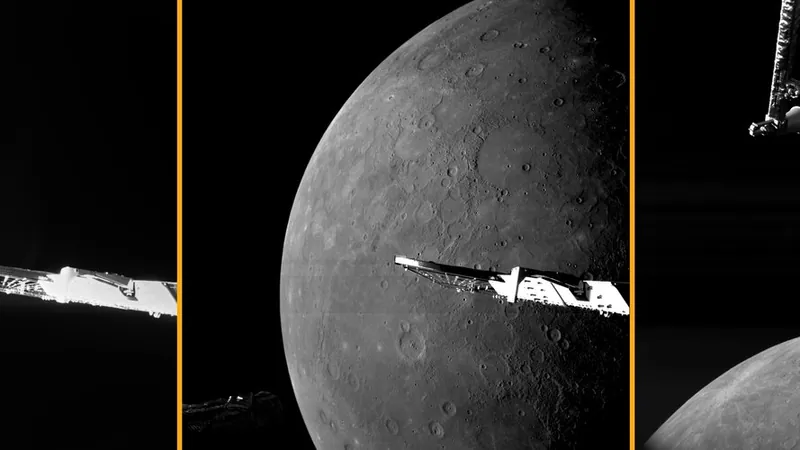
BepiColombo's Sixth Spectacular Flyby of Mercury: Stunning Images Revealed!
2025-01-12
Author: Amelia
BepiColombo's Historic Flyby
The European Space Agency's (ESA) BepiColombo spacecraft is making headlines as it completed its sixth flyby of Mercury, drawing closer to its ultimate goal – entering orbit around the closest planet to the Sun by 2026. As it maneuvers through this gravitational ballet, the mission captures breathtaking images that enhance our understanding of this rocky world, revealing its complex surface and geological history.
Mercury: An Overview
Mercury, known as the smallest planet in our Solar System, boasts a surface that bears a striking resemblance to the Moon, characterized by vast, desolate plains and a myriad of impact craters. Due to its lack of a significant atmosphere and its proximity to the Sun, temperatures on Mercury can soar to an astonishing 472°C (about 882°F) during the day, while at night, they plummet to a bone-chilling -200°C (-328°F). The planet's elliptical orbit allows it to complete a full revolution around the Sun in just 88 Earth days, presenting a constant challenge for astronomers to observe it against the backdrop of the Sunlit sky.
A Historical Context
Historically, only two spacecraft have ventured near Mercury: Mariner 10 and MESSENGER. BepiColombo, launched on October 20, 2018, represents a groundbreaking collaboration between ESA and the Japan Aerospace Exploration Agency (JAXA). This innovative mission consists of two distinct orbiters: the Mercury Planetary Orbiter, operated by ESA, and the Mercury Magnetospheric Orbiter, led by JAXA. Together, they are set to commence operations in early 2027 once they successfully establish their orbits.
Unveiling the First Images
During a press briefing on January 9, 2025, ESA unveiled the first images from BepiColombo’s monitoring cameras (M-CAMs), which have exceeded expectations in their clarity and detail. In the first image, BepiColombo ventured over Mercury’s terminator – the dividing line between the illuminated and dark sides of the planet. This vantage point allowed the probe to explore the permanently shadowed craters near the north pole, revealing fascinating geological features. Notably, craters such as Prokofiev, Kandinsky, Tolkien, and Gordimer exhibit dark floors that are incredibly cold, with surprising evidence of frozen water hiding in the shadows.
Insights from the Second Image
The second image taken during this flyby highlights the volcanic plains known as Borealis Planitia. These expansive smooth surfaces were formed billions of years ago, originating from volcanic eruptions that flooded the landscape with molten lava. The evidence suggests that these plains began developing approximately 3.7 billion years ago. Interestingly, during the eruptions, pre-existing craters, like Henri and Lismer, were buried beneath the flowing lava, leading to the formation of wrinkles in the surface reminiscent of an apple's skin as the planet cooled.
The Final Image: Mercury's Volcanic Activity
The final capture from this flyby offers a glimpse of Mercury’s relentless volcanic activity and impact history. M-CAM 2 showcased a bright region known as Nathair Facula, which is the result of the largest volcanic explosion recorded on Mercury, featuring a central vent stretching 40 kilometers across. Remarkably, geological evidence points to at least three significant eruptions that sent lava cascading up to 150 kilometers away. Contrasting this, the younger Fonteyn Crater, merely 300 million years old, adds layers to our understanding of Mercury's dynamic geological history.
Conclusion
These captivating images not only bring Mercury's enigmatic surface to life but also pave the way for a deeper understanding of its geological processes and the evolution of our Solar System. As BepiColombo continues its mission, the scientific community eagerly anticipates further discoveries that will unravel the mysteries of this intriguing planet. Don't miss out on the groundbreaking revelations expected in the months ahead!



 Brasil (PT)
Brasil (PT)
 Canada (EN)
Canada (EN)
 Chile (ES)
Chile (ES)
 Česko (CS)
Česko (CS)
 대한민국 (KO)
대한민국 (KO)
 España (ES)
España (ES)
 France (FR)
France (FR)
 Hong Kong (EN)
Hong Kong (EN)
 Italia (IT)
Italia (IT)
 日本 (JA)
日本 (JA)
 Magyarország (HU)
Magyarország (HU)
 Norge (NO)
Norge (NO)
 Polska (PL)
Polska (PL)
 Schweiz (DE)
Schweiz (DE)
 Singapore (EN)
Singapore (EN)
 Sverige (SV)
Sverige (SV)
 Suomi (FI)
Suomi (FI)
 Türkiye (TR)
Türkiye (TR)
 الإمارات العربية المتحدة (AR)
الإمارات العربية المتحدة (AR)